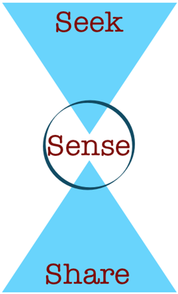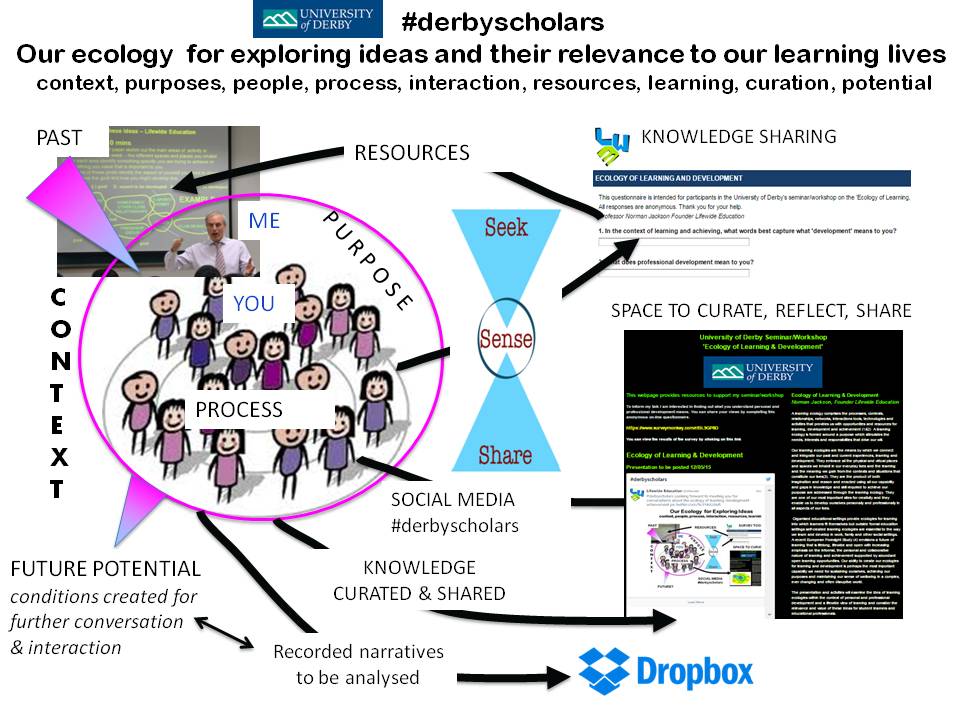
I wanted to connect and integrate my ideas on PLNs with the flow of information and knowledge through my own learning ecology. Using my PLN I discovered the Seek-Sense-Share model of information flow developed by Harold Jarche(2) to represent the way we set out to find information that is relevant to our learning and development projects, make sense and use that information then share with others our understandings.
According to Harold, Personal Knowledge Mastery (PKM) is a framework for individuals to take control of their professional development through a continuous process of seeking, sensing-making, and sharing.
Seeking is finding things out and keeping up to date. Building a network of colleagues is helpful in this regard. It not only allows us to “pull” information, but also have it “pushed” to us by trusted sources. Good curators are valued members of knowledge networks. I think that seeking can be passive - ie we connect to people, communities and organisations who share their knowledge freely and wait with 'watchful anticipation' for something to emerge that is of interest. And then there is the more deliberate mode where we invest lots of time and energy seeking out information that has the potential to be useful.
Sensing is how we personalize information and use it. Sensing includes reflection and putting into practice what we have learned. Often it requires experimentation, as we learn best by doing. Sensing is about trying to make sense of the information we receive or find. We try to connect it to our own understandings which we may need to alter in the process. It is all about creating meaning and then perhaps learning to use what we have learnt.
Sharing includes exchanging resources, ideas, and experiences with our networks as well as collaborating with our colleagues. Sharing involves gifting our understandings or personal sense making to the world either by making it accessible in publications like magazines, books, papers, blogs, twitter posts and any other open access publication vehicles. It's also about using it in work or other social practices.

I decided to personalise Jane's approach and the result is shown in the illustration below. Unlike Jane's disciplined daily routine, my approach to accessing the information flow from my PLN is quite chaotic. But it becomes more disciplined and systematic when I want to learn something. I dedicate the time and resources to SEEKING information that might be relevant (such as what I'm doing now) for a particular purpose. In other words, while this model explains the ongoing information flows in my life, it only springs into action when I have created an ecology for learning or achieving something for which I have a need for new information and knowledge (4).
I use my PLN to SEEK information in two different ways. The first is to provide me with a continuous flow of information that might be of interest and which I might be able to make use of either now or in the future. The second mode becomes active when I engage with a problem and I actively begin to create an ecology within which I SEEK specific information, and individuals inside or outside my existing PLN, who can provide me with information, relevant to my learning project. This is a transactional relationship in which I commit to SHARING some of what I have learnt with the people who include me in their PLN or who in future engage in their own SEEKING for information that I have shared.
In accessing the information I make a judgement as to its relevance, validity and utility and then I either store it or put it to use by bringing it into my learning project. Through a process of trying to understand and apply the information SENSING, I create new meaning and change my own understandings which I can SHARE via my Twitter accounts or through my websites, connections to mail lists or through on-line publications, with other people will be interested. The value of CURATING as part of the infrastructure for sharing is that it provides a context to enable deeper understandings to be made. This in turn stimulates interest and new exchanges with people who I may then include in my PLN.
The SEEK SENSE SHARE model also works well for more dynamic learning ecologies such as a teacher working with her students might experience. For example, while writing this article I facilitated a workshop on the theme of Ecologies for Learning, Development and Achievement. I created a learning ecology in which SEEKING involved inviting them to complete an on-line survey the content of which was included in my presentation. Also during the workshop participants shared their narratives of learning ecologies that they had created and these were recorded for analysis after the workshop. SENSING involved processing the information and narratives I had been given and then the results of this process were SHARED with participants and the conversation continued.
References
1 Stodd J Exploring the Social Age and the New Culture of Learning Lifewide Magazine Issue 11 September 2014 http://www.lifewidemagazine.co.uk/2014.html
2 Jarche H, (2014) The Seek > Sense > Share Framework Inside Learning Technologies January 2014, Posted Monday, 10 February 22 014 http://jarche.com/2014/02/the-seek-sense-share-framework/
3 Hart J (2013) My daily PKM routine (practices and toolset)
http://www.c4lpt.co.uk/blog/2013/11/30/my-daily-pkm-routine-practices-and-toolset/
4 Jackson, N. J. (2013b) Learning Ecology Narratives, in N. J. Jackson and G. B. Cooper (eds) Lifewide Learning, Education and Personal Development E-book Chapter C4 available on line at: http://www.lifewideebook.co.uk/research.html
Norman Jackson
Founder Lifewide Education


 RSS Feed
RSS Feed
